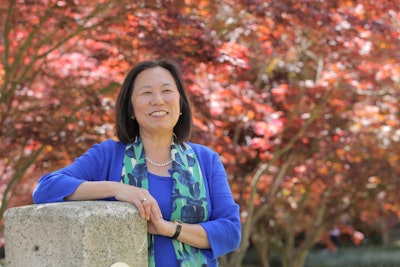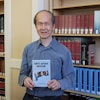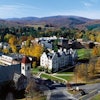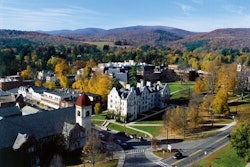Dr. Judy Sakaki, president of Sonoma State University, has been committed to leading, developing and implementing best practices in access, affordability, inclusion and student success.
Sakaki has worked in higher ed for more than 30 years and she is the first Japanese American woman to lead a four-year institution. Sakaki has made strides in improving the graduation rate at SSU since she assumed the SSU presidency in 2016.
In a Q&A with Diverse, Sakaki gives her take on why there are few Asian Americans leading in higher ed, recent hate crimes against members of the AAPI community and how she led her school through the rebuilding process in the aftermath of a devastating wildfire.
DI: When did you know that you wanted to work in higher education?
 Dr. Judy Sakaki
Dr. Judy SakakiJS: I am a first-generation college student. I am who I am because of my cultural background, the experiences that I have had and my education. My life was changed and my eyes were opened to possibilities that I never knew existed because I went to college. As a result, I wanted to work with students. My first job at a university was as an outreach counselor, where I spoke with high school students in Oakland, my hometown, about educational opportunities.
DI: Why do you believe Asian Americans are underrepresented when it comes to the top positions of leadership at higher ed institutions?
JS: That’s a complex question. There were, and still are, so few Asian American leaders in higher education. I never had role models or mentors who looked like me. There is implicit bias and stereotyping. Sometimes a member of a board or search committee may think that an Asian American candidate may not be a strong leader. Additionally, we often do not take sole credit for our accomplishments and we may not tout them enough in an interview. Then, if we do decide to apply for a senior university leadership position, I have found that many Asian Americans and candidates of color simply do not know enough about search firms, executive coaching and other aspects of the search process.
DI: On the school’s website, in the almost five years you have been at SSU, the graduation rate of undergraduate students has increased by 5% to nearly 35%, and the two-year graduation rate for transfer students has increased by 7% to 62.2% which is the highest in the California State University system. What were the factors that contributed to these increases?
JS: Our four-year graduation rate has actually increased to nearly 40%, and we are very proud to have the highest two-year graduation rate for transfer students in the CSU system. Our university is a student-centered campus. We are focused on each student’s success and we have made decisions that support a student’s timely progress to degree completion in line with the system-wide efforts known as Graduation Initiative 2025. With additional funding from the state, we have hired additional academic advisors and mental health counselors, increased the number and diversity of our faculty, added course sections and provided technological support and tools to assist students. Staff and faculty members work to support our students irrespective of whether they are our landscape and food service workers or our deans and cabinet members. We have changed the culture of the campus to be student-centric.
DI: With the number of positive COVID-19 cases dropping in California, the state has started lifting its restrictions and mandates to prevent the spread. Will SSU do the same as well? What COVID-19 protocols do you plan to keep and take away in upcoming semesters?
JS: Our number one priority is the health and safety of all members of our campus community. We are fortunate that with the timely policies and practices that we put in place over the last year, we have been able to keep our campus safe with a minimal number of COVID-19 cases. We are planning for a fall 2021 semester that has more in-person classes, more residential students, more activities and more in-person student support services, including re-opening our dining services. We will still require masks and social distancing. We currently are requiring that certain campus populations, such as student-athletes and residential students, be vaccinated.
DI: You are not only a member of Asian Pacific Americans in Higher Education; you are a founding member. Why was it essential for you to help create this organization? Has membership grown recently?
JS: Over thirty years ago, when Asian Pacific Americans in Higher Education (APAHE) was first formed, there were policies and practices at some universities that were negatively impacting Asian Pacific American (APA) students. A small group of APA educators were concerned about this and wanted a place to address issues affecting APA students, staff, faculty and administrators. At first, the group was California focused, but in 2000, the organization became a national organization. Now there is an annual national conference, a leadership development program, advocacy and regional events. Membership is growing.
DI: You’ve said before that you are a 1st generation college student, just like some of your students today. How has the experience of being a first-generation student impacted your career in higher ed leadership?
 Dr. Judy Sakaki
Dr. Judy SakakiJS: Being a 1st generation college student makes me more sensitive to the needs and experiences of first-generation students. But not having college-educated parents meant that having advisors and mentors who could advise me was extremely important throughout my career. It also meant that I needed to “bring my parents along” and share what I was thinking, how I was changing and what my career plans were. This is important for first-generation students as we advance through our career pathways, because while our parents love us and want to support us, sometimes they may not understand why a career move to another position, institution or region might be desirable or beneficial for our career.
DI: I do not have to tell you that this past year has seen a rise in attacks on Asian Americans. As an Asian American woman, what emotions went through your mind when you heard that eight people (six Asian American women) were gunned down at three Atlanta-based spas in March?
JS: When I first learned about the Atlanta shootings and the death of six Asian American women, I was so sad for the individual women and their families, and I was fearful for the safety of APAs with the increasing acts of violence. Later, as I learned more about the shooting and perpetrator, I felt anger … anger at racism, misogyny, guns and hate.
DI: How did you rebuild after the losses you sustained in the Tubbs fire in 2017, and what was your approach to helping all who were affected at Sonoma State recover?
JS: I lost my home and virtually everything that I owned in the 2017 Tubbs fire. I almost lost my life. I could never have imagined such a terrifying or life-changing experience. Yet, I wasn’t alone. Eighty members of my campus community also lost their homes in that terrible wildfire in California. Unfortunately, our community continues to be faced with the threat of wildfires each year. Our approach in the aftermath of the fires is to offer care and assistance to all on our campus who need help. Fire victims need clothes, a place to live and mental health support. In addition, our student victims need their laptops, books and school supplies to be replaced so that they can resume their studies. We care for and lift each other up with compassion. There is an amazing sense of community. After the 2017 fires, we held a gratitude gathering in our Student Center and also a fundraiser for first responders who lost their homes. I am proud to say that we truly exemplify what we say about Sonoma State. We are a caring university community.
This article originally appeared in the May 13, 2021 edition of Diverse. Read it here.















